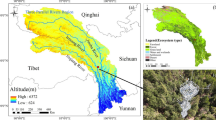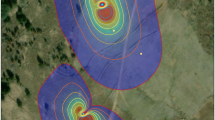Summary
Evapotranspiration of a mixed European beech – Norway spruce forest was measured by means of the eddy covariance technique during a 19 day fine weather period in August 2000. Site conditions were non-ideal as to conventional micrometeorological standards. Sloping terrain and heterogeneously composed, small fetch required a thorough evaluation of the results by (1) the degree of energy balance closure (EBC), (2) footprint analysis and (3) cross-checking against soil water depletion estimates of evapotranspiration. Spatially distributed soil moisture measurements (194 permanent measuring points across a 70 × 70 m plot) guaranteed extended representativeness of the soil water budget method. Due to the convectively active atmosphere during the observation period and to the low measuring height, the source area of the latent heat flux remained small. Footprint analysis revealed that in 95% of the situations with positive net radiation the cumulative latent heat flux reached 50% of the total flux at a maximum upwind distance of 135 (±27) m. Fifty five percent of the peak footprints occurred within the soil moisture measuring plot, providing good spatial comparability between the two methods for determining evapotranspiration. They differed only by 0.2 mm for the whole period, showing better agreement in the second half of the period, when water redistribution in the subsoil had ceased. EBC evaluated on a daily basis ranged between 73 and 92%. No clear relation between magnitude of the closure gap and meteorological parameters could be identified. Overall, 46% of the incident net radiation drove evapotranspiration and 28% were released as sensible heat, the Bowen ratio being sensitive to weather conditions and wind direction, though. The results of this study give confidence that the eddy covariance technique is a useful tool to measure forest evapotranspiration also in complex terrain.
Similar content being viewed by others
Author information
Authors and Affiliations
Rights and permissions
About this article
Cite this article
Schume, H., Hager, H. & Jost, G. Water and energy exchange above a mixed European Beech – Norway Spruce forest canopy: a comparison of eddy covariance against soil water depletion measurement. Theor. Appl. Climatol. 81, 87–100 (2005). https://doi.org/10.1007/s00704-004-0086-z
Received:
Revised:
Accepted:
Published:
Issue Date:
DOI: https://doi.org/10.1007/s00704-004-0086-z




